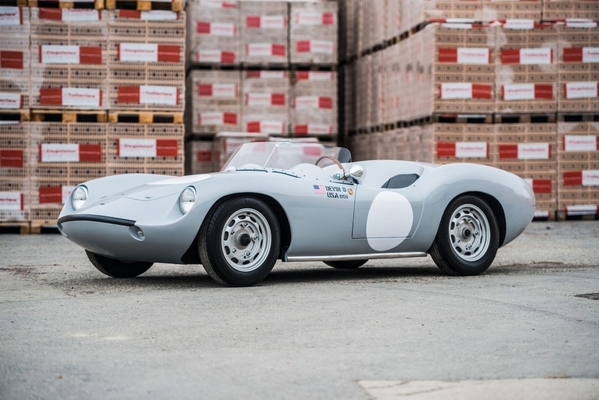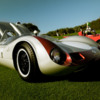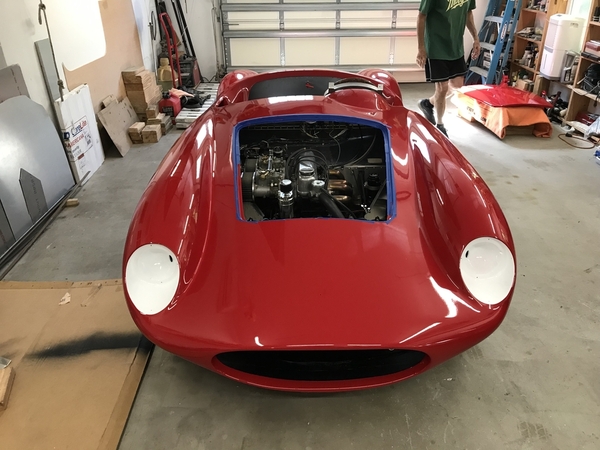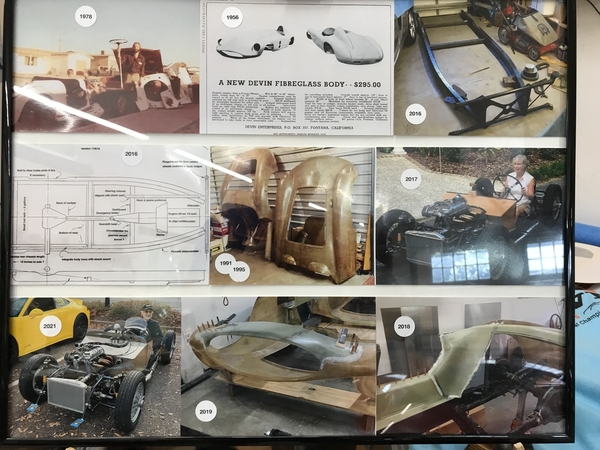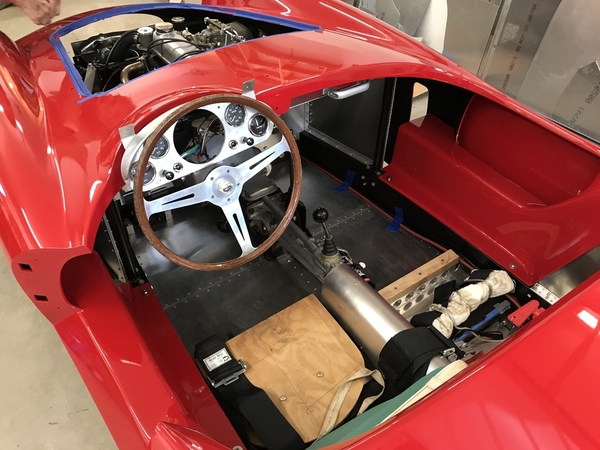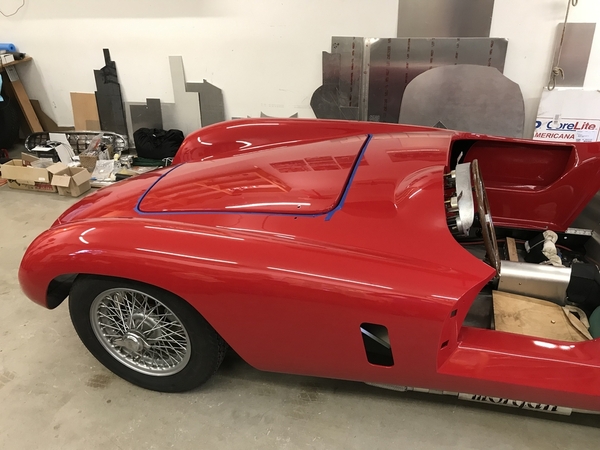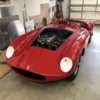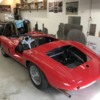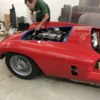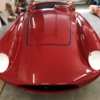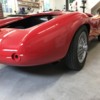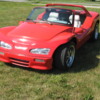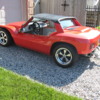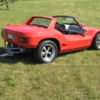"This Porsche-Sabel Mk1 Prototype was the first of approximately 30 cars built by John Sabel beginning in the early 1960's, and was John's personal car...". 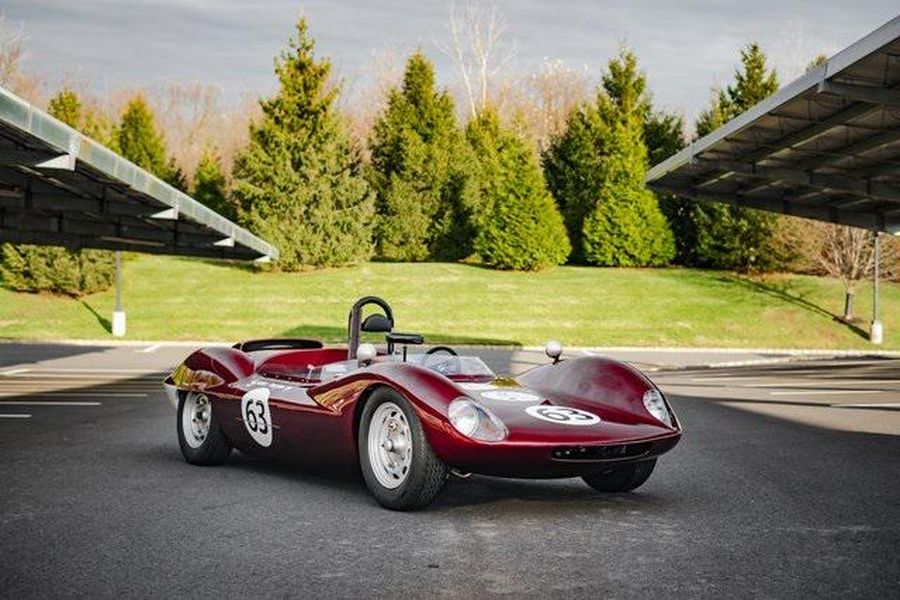
Replies sorted oldest to newest
Looks like quite the "Grocery-Getter"!
I wouldn't feel embarrassed at all driving that at a vintage event! Although I might have to resort to the roll out onto the ground technique to exit the vehicle.
"Inquire" always means I won't, because if I have to ask...
It's a kit car on a VW pan.
@edsnova posted:It's a kit car on a VW pan.
And a few Porsche parts, but you're right, it's a fancy VW.
@Michael Pickett posted:And a few Porsche parts, but you're right, it's a fancy VW.
Apparently with enough Porsche parts to call it a Porsche, who knew?
@edsnova posted:It's a kit car on a VW pan.
It's interesting, I'd like to see some under-pan & suspension pics...
if you look at 356 parts and VW parts they are "identical" but "different" just enough not to be interchanged. example.. the oil fill/generator support is the same height from base to generator centerline... but the bolt pattern where it mounts on the case is rectangular on 356 and square on VW. Why, my guess is because one is 'P' and the other is VW.
What is the percentage of Porsche parts required on a car to make it a Porsche?
I always thought it came down to the VIN.
No subjectivity there.
I'd like to know that myself. :-)
Actually, there is some good history on the Sabel build - it's quite interesting, if I recall, how Porsche jumped in to grab the name.
This car is being sold by Gaswerks in North Jersey. "The guy" there is Gaspar, I was introduced to him at LRP. Nice guy, does meticulous work.
I wish there were more "under" pics.
VW and 356 parts are similar, but I'm not sure a lot of them are identical. Axle tubes yes. Front drums and bearings can be made to work. You can get a 356 fan and shroud to fit. But not much else. Trans mounts(3 of them) are all different. Beams are different.
I posted not to disparage—I love this thing—but to emphasize once again how blurry the line once was between "kit car" (or "replica," if you prefer), "custom," "race special" and factory. All of our cars are rooted in that '50s diy builder/racer tradition, back when fiberglass vs aluminum was a practical question, not a mater of aesthetics, authenticity or class, and form followed function in a way that I think we all agree was at an artistic pinnacle.
Just look at this magnificent old beast.

I could only add that my 1956 356 A Coupe had several suspension parts on it with the VW logo embossed. Early on there was a lot they took right out of the VW parts bins.
What is the wheelbase ? VW or 356 or something in the middle ?
I really like the car , just wondering about the 61 Porsche part
@imperial posted:What is the wheelbase ? VW or 356 or something in the middle ?
I really like the car , just wondering about the 61 Porsche part
The shots of the pan looked very much like an uncut Beetle. The '61 Porsche part was the engine, I would guess.
Ed's right about this. The line here is very, very blurry between "kit car" and "custom". I think the Porsche guys are OK with it because it's not a reproduction (forgery?) of an existing Porsche icon.
My license plate frame says, "Meine Fälschung" ("My Forgery"), so I obviously couldn't care less about where anybody draws the line, but some people really get their panties in a bunch about it.
I see a lot of similarities to the Devin D. The D did not use a VW chassis, but a ladder frame. I would not consider these a kit car, but I'm not sure what one would call it. Maybe a fiberglass coach built? They were very light, and could run circles around a speedster.
Attachments
I love everything about the Devin… except the bodywork. That’s where it looks very, very “homemade”.
@Stan Galat posted:I love everything about the Devin… except the bodywork. That’s where it looks very, very “homemade”.
I like the shape except for the "under bite."
@Michael Pickett posted:I like the shape except for the "under bite."
I'm less than wild about how deeply the bodyline dips at the trailing edge of the door, then rises abruptly to the rear fenders, but I could learn to live with it.
The nose is deeply unfortunate and I'm not sure I could ever get over it.
@Michael Pickett posted:I like the shape except for the "under bite."
I agree with you, Mike. Probably not great for high speed aerodynamics either.
.
@Panhandle Bob posted:....What is the percentage of Porsche parts required on a car to make it a Porsche?...
It's not the percentage of parts.
If you want to sell it, it's a Porsche.
If you want to buy it, it's a VW.
.
@Sacto Mitch posted:.
It's not the percentage of parts.
If you want to sell it, it's a Porsche.
If you want to buy it, it's a VW.
.
ask a 914 or a 924 ........
@edsnova posted:Just look at this magnificent old beast.
I’m with you, Ed. Late 50’s, early 60’s Sports Racers are without a doubt my favorite class of cars. Fiberglass bodies on modified or repurposed road car frames were SOP.
My imaginary internet friend from Florida who’s owned 50-60 Porsches once owned an Elva-Porsche. He said it never handled well. (But admitted under cross that he never devoted the time to get it right. He was racing 911Rs and RSRs at the time. And sold it to finance his 910 restoration.)
He got a cold call one day by someone who had heard through the grapevine that he had one. Turned out the caller was Bobby Rahal, and it was his first-ever race car. He sold it and Bobby had it completely restored.
Pretty cool cars. Much like a Spyder, with a flat fan Fuhrman. (548?)
Attachments
@Stan Galat posted:I'm less than wild about how deeply the bodyline dips at the trailing edge of the door, then rises abruptly to the rear fenders, but I could learn to live with it.
I don’t mind it so much. OTOH, it’s one of the things I hate about the Cobra S/C. Probably because the flares. (Which I think ruins the lines of the original Ace/289)
Loved Devins ever since I first saw them in R&T BITD.

BTW, ICYMI, someone bought the old body molds and put them back in production. I don’t think they make the VW variant, but they can make replacement panels special order. If I had $100K burning a hole in my pocket I’d be hard pressed to decide between a new Devin and a Kirkhams 289 FIA.
Attachments
@LI-Rick posted:
BITD, A Devin body was $250. Granted, it was 1960 money, but still.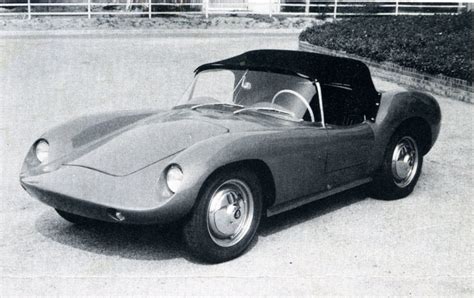
Attachments
Devin D or Devin C has a factory VIN number stamped into the tube chassis up by the front suspension , The Devin C used a VW front suspension and Corvair rear A-arms.
Devin also made a body to fit a vw floorpan
@dlearl476 posted:BITD, A Devin body was $250. Granted, it was 1960 money, but still.
Like they say about those painted Elvis plates, "some are known to go up in value":
Some of you may recall the pictures I posted some time back about beautiful Devin-Morgan a friend of mine built. The body is beautiful because he taught himself how to do fiberglass far better than the Devin folks did. He had the body (in two halves, front and rear) hanging on his wall for years. There was no gelcoat and the fiberglass was this enough to see light through. The surface was fairly smooth, but the edges were rough and the panels didn't fit worth a damn. There was no/none/zero internal structure pr bracing of any kind. He fabricated new doors and a new trunk panel as well as internal structure, and he reshaped the front end a bit. The body is perfect now. I'll see if I can locate my pictures.
The body he started with was a front-engine one probably for a TR3 chassis or something like that. He had a Morgan-style frame fabricated to his design and used Morgan mechanical bits. Internal bracing was fabricated from aluminum sheet. I think the engine is a 1600cc Ford crossflow with dual SUs. I drove it once when it was a bare chassis with lights and a fully legal (in SC) license plate, but no body. Didn't weigh 1000 pounds and was very quick, albeit a bit breezy. He built the car to fit himself (as you would expect) and now that the body is on, I don't fit behind the wheel. To bad. It looks like the Ferrari race cars from the late 50s/early 60s that I dearly love.
Attachments
WOW!
What skills.
Makes building a Speedster look almost easy, doesn't it?
The wire wheels just look so right on that Devin.
@Lane Anderson posted:Makes building a Speedster look almost easy, doesn't it?
It's the things you can't see in those pictures that give me respect for your friend.
I had a buddy who bought a '65 Mustang and the start of the "pro-street" movement. We didn't know sheet-metal working from jack, but we knew how to stick-weld. As a result, we fabbed up some giant tubs in the back of the car with 16 ga. steel, which was about as thin as we could go with the skills we had. The welds were great, but we'd added probably 300 lbs to the back-end of the car.
What brings this to mind is your description of the fiberglass. Steve bought a fiberglass front end for that car, and it arrived looking just like you describe, Lane - no gel-coat and so thin that light easily shone through it.
I can't imagine the work involved in making my own bucks and laying my own fiberglass, as your friend did. There's skills there that don't come out in the pictures. I'm sure that was just a small part of what he needed to invent to get the car on the road.
Here is a car I built when I was young and foolish. Started out as a Wrangler dune-buggy. 5 years of mould-making and glass work later, it was finished. It was featured in Hot VW's back in 1988, my two minutes of fame. HA HA
Attachments
Finally! I see another car with a Berg Extractor like mine.
It came with the "Stinger" megaphone like yours but I've never run it - I think that is now wall decór over in my son's shop these days.
You should be proud of that work, Jesse. That is one very cool Buggy. The interior alone is better than most I've seen and light years ahead of my first Buggy (but then I was only 17 when I built it and it was fab'd from marine plywood!)
Nice work, Jesse!
@Stan Galat posted:It's the things you can't see in those pictures that give me respect for your friend.
I had a buddy who bought a '65 Mustang and the start of the "pro-street" movement. We didn't know sheet-metal working from jack, but we knew how to stick-weld. As a result, we fabbed up some giant tubs in the back of the car with 16 ga. steel, which was about as thin as we could go with the skills we had. The welds were great, but we'd added probably 300 lbs to the back-end of the car.
What brings this to mind is your description of the fiberglass. Steve bought a fiberglass front end for that car, and it arrived looking just like you describe, Lane - no gel-coat and so thin that light easily shone through it.
I can't imagine the work involved in making my own bucks and laying my own fiberglass, as your friend did. There's skills there that don't come out in the pictures. I'm sure that was just a small part of what he needed to invent to get the car on the road.
He's also made a 1/2 tonneau and race faring, neither of which I have yet seen mounted.
Of course he did.
BTW: The front end of the water-cooled Devin looks great. Your friend's car is all that.


